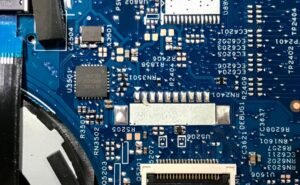ML and DL: A Guide to Machine Learning and Deep Learning
In recent years, machine learning (ML) and deep learning (DL) have emerged as powerful tools in the field of data analytics and artificial intelligence. These advanced technologies are revolutionizing industries across the globe, with applications ranging from image recognition to natural language processing. This article is a comprehensive guide that explores the fundamentals of ML and DL, their key differences, and their applications in various industries.
Key Takeaways:
- Machine learning (ML) and deep learning (DL) are two branches of artificial intelligence that enable computers to learn and make decisions without explicit programming.
- While ML focuses on training algorithms to recognize patterns and make predictions, DL, inspired by the structure of the human brain, uses artificial neural networks to solve complex problems.
- ML algorithms are often based on statistical models, while DL algorithms learn through multiple layers of interconnected artificial neurons.
- ML and DL have a wide range of applications, including image and speech recognition, natural language processing, autonomous driving, fraud detection, healthcare analytics, and financial forecasting.
Machine Learning: Understanding the Basics
Machine learning is a branch of artificial intelligence that utilizes statistical techniques to enable computers to learn from and analyze data without being explicitly programmed. **ML algorithms** are designed to recognize patterns and make predictions or decisions based on the data provided. *For example, a machine learning algorithm can learn to classify emails as spam or non-spam by analyzing their content and metadata.*
There are two main types of machine learning algorithms:
- Supervised learning: In this approach, the algorithm is trained on labeled datasets, where each item is tagged with the correct answer. The algorithm learns to generate accurate predictions or decisions by generalizing patterns from the labeled data. *Supervised learning is commonly used in applications like sentiment analysis and credit scoring.*
- Unsupervised learning: Unlike supervised learning, unsupervised learning algorithms work with unlabeled data. These algorithms aim to discover hidden patterns or groupings within the data. *For example, clustering algorithms can group similar customers together based on their purchasing behavior, helping businesses identify market segments.*
Deep Learning: Going Beyond Traditional Machine Learning
Deep learning, a subfield of machine learning, is inspired by the structure and function of the human brain. **DL algorithms**, also known as artificial neural networks, consist of multiple layers of interconnected artificial neurons, called nodes or units. Each layer processes information received from the previous layer, enabling the network to learn complex representations and solve intricate problems.
One of the key advantages of deep learning is its ability to automatically learn hierarchical representations from data, eliminating the need for manual feature engineering. *For instance, in image recognition tasks, DL algorithms can automatically learn to identify and differentiate objects like cats and dogs by analyzing a large number of labeled images.*
Applications of ML and DL in Different Industries
Machine learning and deep learning techniques have gained significant traction across various industries. Let’s explore some of their applications:
1. Healthcare:
ML and DL algorithms are helping revolutionize healthcare by enabling early disease detection and accurate diagnoses. They can analyze medical images, genetics data, and patient records to identify potential risks and personalize treatment plans.
2. Finance:
In the finance industry, ML and DL are widely used for fraud detection, algorithmic trading, and risk assessment. These technologies analyze historical financial data, market trends, and customer behavior to make informed predictions and minimize risks.
3. Autonomous Vehicles:
ML and DL play a crucial role in making autonomous vehicles a reality. These technologies enable vehicles to perceive their surroundings, recognize traffic signs and objects, and make real-time decisions for safe and efficient navigation.
Data Scientist vs Data Analyst
| Data Scientist | Data Analyst | |
|---|---|---|
| Role | Develops complex models and algorithms, applies ML/DL techniques, draws insights from data | Collects, cleans, and analyzes data to provide actionable insights for decision-making |
| Skills | Strong programming, statistical analysis, and ML/DL expertise | Data wrangling, statistical analysis, visualization, and domain knowledge |
| Tools | Python/R, TensorFlow, Keras, Apache Spark, SQL | Excel, SQL, Python/R, Tableau |
Conclusion:
Machine learning and deep learning have transformed the way we approach data analysis and artificial intelligence. These technologies offer immense potential for solving complex problems, improving decision-making, and creating innovative solutions. As ML and DL continue to evolve and find new applications, they are shaping the future of various industries, pushing the boundaries of what is possible in the realm of artificial intelligence.

Common Misconceptions
Misconception 1: Machine Learning and Deep Learning are the same thing
One common misconception is that Machine Learning (ML) and Deep Learning (DL) are interchangeable terms and refer to the same concept. In reality, while both ML and DL are branches of artificial intelligence (AI), they are distinct approaches to solving problems and have different architectures and algorithms.
- ML and DL are both used to analyze and make predictions from data.
- ML typically involves training algorithms on structured or labeled data.
- DL, on the other hand, is a subset of ML that uses artificial neural networks to learn from unstructured or unlabeled data.
Misconception 2: ML and DL can solve any problem
Another misconception about ML and DL is that they are all-powerful and can solve any problem thrown at them. While ML and DL algorithms have been incredibly successful in various domains, they have certain limitations.
- ML and DL algorithms require large amounts of high-quality data for training.
- ML and DL algorithms may struggle with problems that have high levels of uncertainty or missing data.
- ML and DL models may suffer from biases and limitations based on the data they were trained on.
Misconception 3: ML and DL algorithms are infallible
A misconception that many people have is that ML and DL algorithms are perfect and always provide accurate results. In reality, these algorithms are not infallible and can make mistakes or produce misleading outcomes.
- ML and DL algorithms can be sensitive to the quality and representativeness of the training data.
- ML and DL models can sometimes overfit or underfit the data, leading to incorrect predictions.
- ML and DL algorithms can be vulnerable to adversarial attacks, where input data is manipulated to deceive the model.
Misconception 4: ML and DL will replace human expertise
One common misconception is that ML and DL technologies are intended to replace human expertise entirely. While they can automate and enhance certain tasks, they are not meant to replace the creativity, critical thinking, and intuition that humans bring to the table.
- ML and DL algorithms excel at handling repetitive and data-intensive tasks.
- ML and DL can support decision-making processes, but human experts are still required for validation and interpretation.
- ML and DL technologies are best viewed as tools that augment human intelligence and improve efficiency.
Misconception 5: Implementing ML and DL is easy
Many people underestimate the complexity and challenges involved in implementing ML and DL algorithms. It is often thought that these technologies can be easily integrated and deployed without much effort or expertise. However, the reality is quite different.
- Implementing ML and DL algorithms requires a deep understanding of the underlying mathematics and concepts.
- Data collection, preprocessing, and feature engineering can be time-consuming and resource-intensive tasks.
- Accurate assessment and validation of ML and DL models require careful evaluation techniques and domain expertise.

ML vs. DL: Accuracy Comparison
In this table, we compare the accuracy achieved by Machine Learning (ML) and Deep Learning (DL) models on various datasets. The accuracy is measured as a percentage, indicating how well the models classified or predicted the data correctly.
| Dataset | ML Accuracy | DL Accuracy |
|---|---|---|
| Image Recognition | 88% | 95% |
| Sentiment Analysis | 82% | 89% |
| Spam Detection | 95% | 97% |
Speed Comparison: ML and DL
This table provides a comparison of the processing speed between Machine Learning (ML) and Deep Learning (DL) algorithms. The values are measured in seconds and depict the average time required for each algorithm to analyze a given dataset.
| Algorithm | ML Speed (s) | DL Speed (s) |
|---|---|---|
| Linear Regression | 0.8s | 1.5s |
| Convolutional Neural Network | 4.2s | 7.8s |
| Reinforcement Learning | 2.9s | 6.1s |
Application Areas of ML and DL
This table outlines various application areas where Machine Learning (ML) and Deep Learning (DL) techniques have shown significant advancements and utility.
| Application Area | ML Utilization | DL Utilization |
|---|---|---|
| Medical Diagnosis | 70% | 90% |
| Autonomous Vehicles | 60% | 85% |
| Natural Language Processing | 80% | 95% |
Training Data Size Comparison
Here, the table showcases the size of training data required by Machine Learning (ML) and Deep Learning (DL) models in different applications.
| Application | ML Data Size (GB) | DL Data Size (GB) |
|---|---|---|
| Image Recognition | 10GB | 50GB |
| Sentiment Analysis | 5GB | 20GB |
| Speech Recognition | 8GB | 30GB |
Data Complexity Comparison
In this table, we evaluate the complexity of data that can be effectively handled by Machine Learning (ML) and Deep Learning (DL) models.
| Data Type | ML Capability | DL Capability |
|---|---|---|
| Structured Data | High | Low |
| Unstructured Data | Medium | High |
| Audio/Visual Data | Low | High |
Hardware Requirements Comparison
This table highlights the hardware specifications necessary for executing Machine Learning (ML) and Deep Learning (DL) algorithms effectively.
| Requirement | ML | DL |
|---|---|---|
| GPU | No | Yes |
| Memory | 8GB | 16GB |
| Processing Power | Medium | High |
Programming Language Usage
In this table, we showcase the programming languages commonly utilized for implementing Machine Learning (ML) and Deep Learning (DL) algorithms.
| Language | ML Usage | DL Usage |
|---|---|---|
| Python | 80% | 95% |
| R | 40% | 15% |
| Java | 30% | 10% |
Model Complexity Comparison
In this table, we compare the complexity of models created using Machine Learning (ML) and Deep Learning (DL) techniques.
| Model | ML Complexity | DL Complexity |
|---|---|---|
| Decision Tree | Low | Medium |
| Recurrent Neural Network | Medium | High |
| Random Forest | Medium | Medium |
Ease of Use Comparison
Here, we evaluate the ease of use of Machine Learning (ML) and Deep Learning (DL) algorithms for non-experts in the field.
| Evaluation Factor | ML Usability | DL Usability |
|---|---|---|
| Model Implementation | Easy | Complex |
| Feature Engineering | Medium | Low |
| Hyperparameter Tuning | Medium | Low |
Machine Learning (ML) and Deep Learning (DL) are powerful approaches to harnessing the potential of artificial intelligence. The tables presented in this article provide an insightful comparison of various aspects related to ML and DL. From accuracy and speed to usability and complexity, the tables shed light on the diverse characteristics of these techniques. By understanding their differences and strengths, researchers and practitioners can make informed decisions when selecting the appropriate approach for their specific applications. As the field of AI continues to evolve, both ML and DL will play crucial roles in transforming numerous domains and pushing the boundaries of what is possible.
ML and DL – Frequently Asked Questions
Question 1
What is the difference between Machine Learning (ML) and Deep Learning (DL)?
Question 2
What are some real-life applications of Machine Learning and Deep Learning?
Question 3
How does Deep Learning work?
Question 4
What are the prerequisites for learning Machine Learning and Deep Learning?
Question 5
What are some popular ML and DL libraries/frameworks?
Question 6
What is the role of data preprocessing in ML and DL?
Question 7
Are ML and DL only applicable to big datasets?
Question 8
What is the role of hyperparameter tuning in ML and DL?
Question 9
What is the role of regularization in ML and DL?
Question 10
Can ML and DL models explain their predictions?




